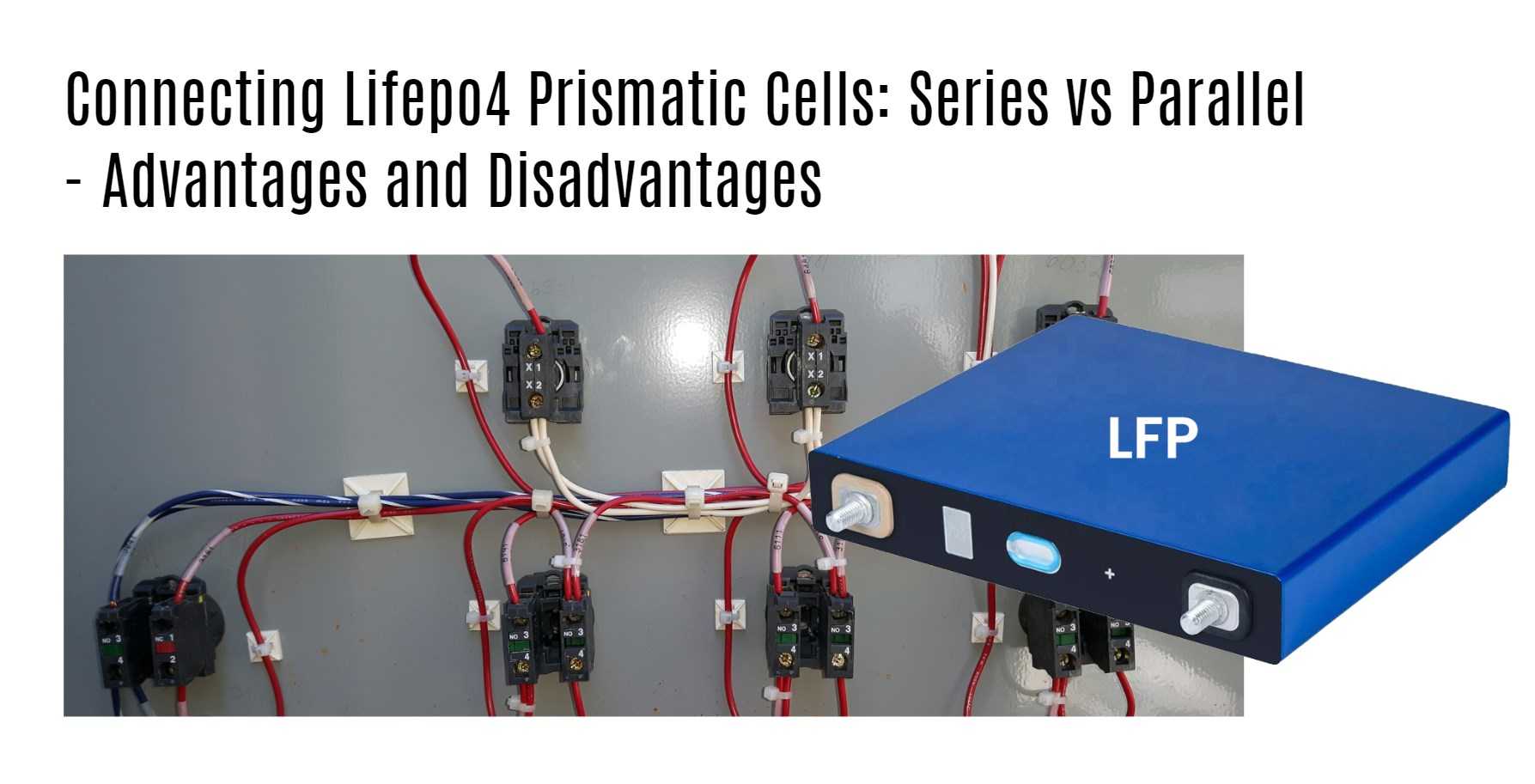Discover how to connect LiFePO4 prismatic cells in series or parallel to form a battery pack. Connecting in series involves linking the positive terminal of one cell to the negative terminal of the next, increasing voltage output. Connecting in parallel involves connecting all positive terminals together and all negative terminals together, increasing capacity. Consider the advantages and disadvantages of each connection type, such as higher voltage output in series and increased capacity in parallel. Choose the connection type that suits your specific application requirements.
Tools and Materials Needed
- Safety Guidelines and Preparation:
- Work in a well-ventilated area and wear appropriate personal protective equipment (PPE).
- Have a fire extinguisher nearby, especially when working with larger batteries.
- Gathering Tools and Materials:
- LiFePO4 battery cells (prismatic cells)
- Nickel strips or busbars for connecting the cells
- Spot welder or soldering iron with temperature control
- Insulating materials like fish paper or Kapton tape
- Battery management system (BMS) for monitoring and protection
- Battery enclosure or case for housing the cells
- Wiring and connectors for connecting the cells and external devices
- Heat shrink tubing for insulation
- Multimeter for voltage measurement and testing
- Basic hand tools like screwdrivers for assembly
- Proper Assembly Process:
- Plan the arrangement and configuration of the battery pack, considering factors like cooling, accessibility, and wiring management.
- Prepare the battery cells by inspecting for damage, grouping cells with similar voltage and capacity, and connecting them with nickel strips or busbars.
- Install the battery management system (BMS) following the manufacturer’s instructions and ensure proper calibration.
- Insulate and secure the cells within the battery enclosure using suitable materials and mounts.
- Connect the wiring, ensuring correct polarity, and double-check all connections for accuracy and tightness.
- Test the battery pack using a multimeter to measure voltage and perform functionality tests.
- Enclose and seal the battery pack inside the designated enclosure, ensuring proper ventilation if needed, and label with important information.
- Conduct charge and discharge tests to verify performance and stability.
- Document the assembly process, including diagrams, specifications, and test results, and provide instructions for proper use, charging, and maintenance.
While not an extensive list of items required for connecting lifepo4 prismatic cells in series or parallel configurations – having these essential tools and materials ready before starting will make the task much easier!
Lifepo4 Cell Connections
Discover how to connect LiFePO4 cells and explore the pros and cons of different connection types. Whether you choose to use a battery charger, a cable and connector, or a wireless charging system, it is crucial to follow the proper steps and guidelines for a safe and successful connection. LiFePO4 battery cells offer benefits such as lower cost, longer lifespan, shorter charging time, and enhanced safety compared to traditional battery cells.
Wholesale lithium golf cart batteries with 10-year life? Check here.
- Connecting LiFePO4 Cells:
-
Option 1: Battery Charger
- Use a battery charger specifically designed for LiFePO4 cells.
- Follow the manufacturer’s instructions for proper charging and connection.
- Ensure the charger is compatible with the voltage and capacity of your LiFePO4 cells.
-
Option 2: Cable and Connector
- Use a cable and connector suitable for LiFePO4 cell connections.
- Connect the positive and negative terminals of the cells using the appropriate wiring and connectors.
- Ensure proper polarity and secure connections for reliable performance.
-
Option 3: Wireless Charging System
- Utilize a wireless charging system compatible with LiFePO4 cells.
- Place the LiFePO4 cells on the charging pad or within the designated charging area.
- Follow the manufacturer’s instructions for proper alignment and charging duration.
- Pros and Cons of Different Connection Types:
-
Battery Charger:
- Pros: Convenient and reliable charging method, suitable for various LiFePO4 cell configurations.
- Cons: Requires access to a power source, may have limitations in charging speed.
-
Cable and Connector:
- Pros: Provides flexibility in cell arrangement and easy replacement of individual cells.
- Cons: Requires proper wiring and connector selection, may require additional insulation and protection.
-
Wireless Charging System:
- Pros: No physical connection required, convenient for portable devices.
- Cons: Limited charging distance, slower charging speed compared to direct connections.
Series vs Parallel Connection
- Series Connection:
-
Advantages:
- Higher voltage output, ideal for applications requiring high voltage.
- Allows for efficient use of cells with lower voltage ratings.
- Can provide higher power output.
-
Disadvantages:
- If one cell fails or becomes damaged, the entire battery pack may fail.
- Requires careful monitoring of individual cell voltages to prevent overcharging or undercharging.
- Parallel Connection:
-
Advantages:
- Increased capacity, suitable for applications requiring longer runtime.
- Provides redundancy in case of cell failure, as only a portion of the overall capacity will be lost.
- Can deliver higher current output.
-
Disadvantages:
- Adding more cells to increase capacity may result in a bulkier and heavier battery pack.
- Requires proper balancing and monitoring of individual cells to prevent issues like thermal runaway.
- Considerations for Choosing the Connection Type:
- Voltage Requirements: If your application requires higher voltage, a series connection is suitable.
- Capacity Needs: If you need increased capacity and longer runtime, a parallel connection is preferable.
- Safety: Series connections increase the risk of overcharging or undercharging individual cells, while parallel connections increase the risk of short circuits and thermal runaway.
- Cost: Parallel connections require more wiring and balancing circuitry, which can drive up costs.
However, if you require increased run time rather than peak power delivery from your battery pack then parallel connections may be better suited due to their greater current output capabilities.
Want OEM lithium forklift batteries at wholesale prices? Check here.
Ultimately deciding which connection method is best requires evaluating what is required by taking into account technical details such as discharge rate requirements or specific voltages needed for particular applications.
Advantages and Disadvantages of Each Connection Type
Discover the advantages and disadvantages of a series connection in a circuit. The advantages include the same current flowing through all components, the ability to obtain a higher resistance value, and the ability to light multiple low voltage bulbs in series. However, the main disadvantage is that if one component fails, the entire circuit is affected.
As for parallel connection in a circuit, the advantages include the ability to handle breaks in the circuit, as the current can pass through different paths, and the ability to maintain the same voltage as a single power source. However, parallel circuits can be more complex and costly to construct.
Series and parallel connections are two methods of connecting lifepo4 prismatic cells to form a battery pack. Each connection type has its own unique advantages and disadvantages.
One advantage of series connection is that it increases the voltage output, making it ideal for applications that require high voltage such as electric vehicles. However, one disadvantage is that if one cell fails or becomes damaged, the entire battery pack will fail.
On the other hand, parallel connection increases the capacity of the battery pack without increasing its voltage output. It also provides redundancy in case one cell fails since only a portion of the overall capacity will be lost. However, adding more cells to increase capacity may result in a bulkier and heavier battery pack.
The decision on which connection type to use ultimately depends on your specific application’s requirements and limitations. For instance, if you need higher voltage but can’t afford any loss in overall capacity due to failure risks then series connection might suit you best; whereas if redundancy is key with minimal size increase then parallel connections should be used instead.
By understanding these advantages and disadvantages carefully before deciding which method suits your needs better – you can ensure optimal performance from your Lifepo4 prismatic cell batteries for your projects!
How to Decide Which Connection Type to Use
- Number of Users:
- Assess the number of users who will be accessing the network. This helps determine the capacity and scalability needed for the connection type.
- Network Traffic:
- Consider the amount of network traffic generated by the users and applications. Higher traffic may require a connection type with greater bandwidth and capacity.
- Bandwidth Requirements:
- Evaluate the bandwidth requirements of the applications used in the network. Some applications may require higher bandwidth, necessitating a connection type that can handle the data transfer efficiently.
Who makes prismatic batteries?
- CATL:
- CATL, headquartered in Ningde, Fujian, is a global leader in prismatic cell manufacturing. It ranks first in global installed capacity and has a stable market share in China. With a wide range of customers, CATL caters to the needs of various car companies.
- BYD:
- BYD, based in Shenzhen, Guangdong, is a new technology private enterprise with expertise in prismatic cell manufacturing. It has built production bases in different locations and is known for its prismatic aluminum shell batteries used in models.
- SAIC:
- SAIC Times Power Battery System Co., Ltd. is a joint venture between SAIC and CATL. It focuses on prismatic cells and provides power battery systems to SAIC Motor, SAIC GM, SAIC Volkswagen, and SAIC Maxus.







